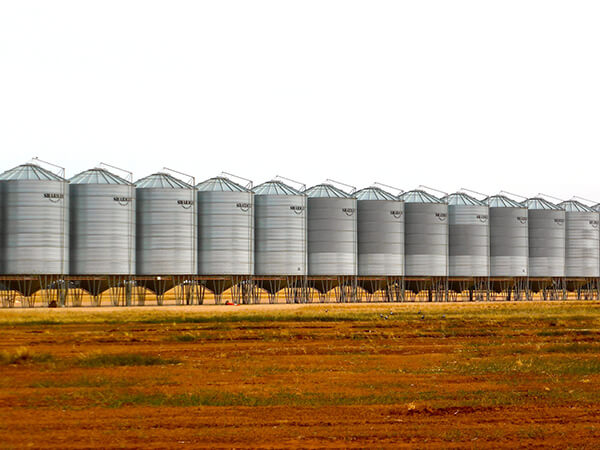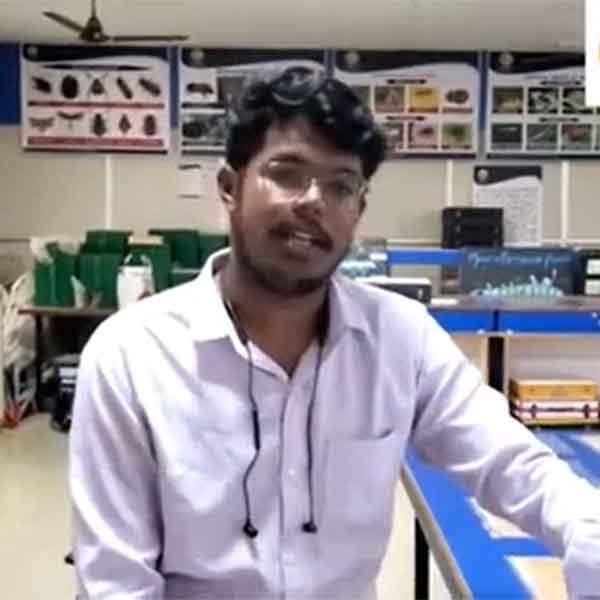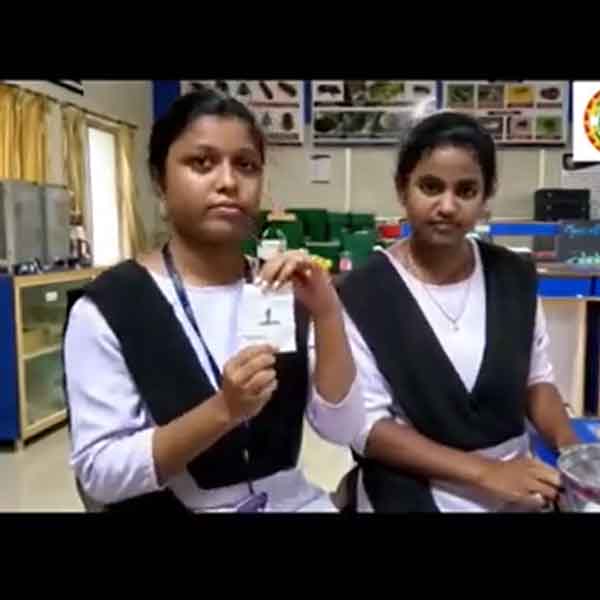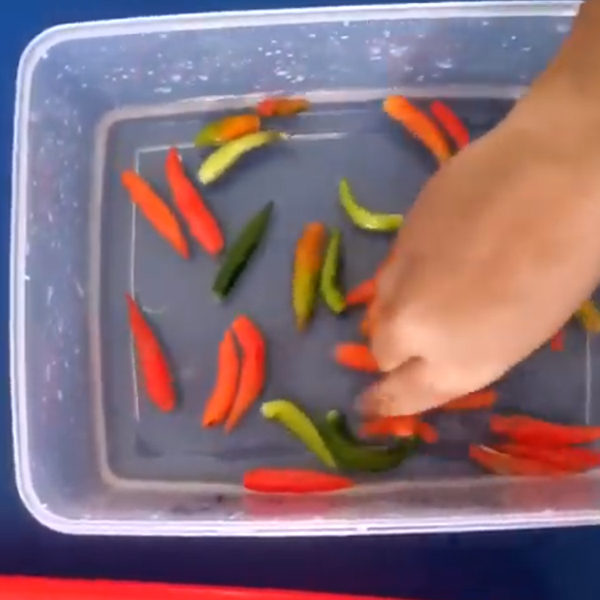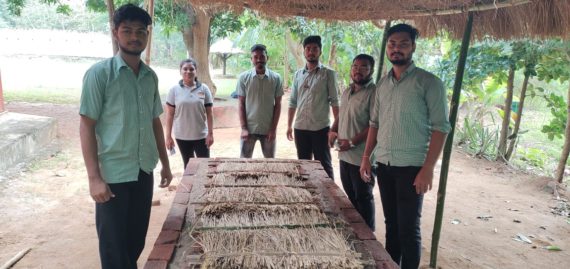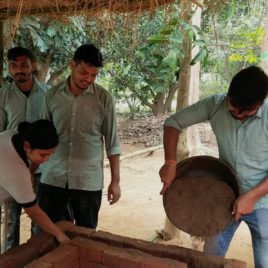This domain focus on the various factors responsible for the deterioration or loss of a commodity or food products under storage condition. It also deals with the techniques and methods required to prevent such damage.
Commodity and Food Storage
Domain Track: Commodity and Food Storage
Course Attendees
Still no participant
Course Reviews
Still no reviews
Track Total Credits (T-P-P) (3-15-11) = Total (29)
Courses Division:
- Storage Entomology (1-2-0)
- Seed pathology (1-2-0)
- Post-harvest biochemistry and physiology of crops (1-2-0)
- Recent trends in post-harvest technology (0-3-0)
- Pest management techniques in storage (0-3-0)
- Post-harvest storage of fruits and vegetables (0-3-0)
- Project (0-0-11)
Domain Track Objectives:
The track courses aims at providing detailed knowledge on various factors causing the loss in the commodity and food under storage condition. It also aims at management of vaious pests and diseases through recent techniques. Here we greatly deal with various types of storage methods and techniques.
To gain knowledge on
- Storage structures
- Pests and diseases in storage and their management
- Grain deterioration and their management
- Safe storage of fruits and vegetables
- Hands-on practice on safe storage techniques
Domain Track Learning Outcomes:
- Thorough knowledge on safe storage of commodity and food
- Skill development on Identification of pests and diseases and their management
- Hands-on Training of new techniques in storage
- Practical exposure to commercial safety procedures and maintenance of commodity and food in storage
- Knowlege on food security issues
Career Scope:
- Warehouse Manager
- Food safety officer
- Storage administrator
- Agricultural Commodities Inspector
- Agricultural Specialist
Domain Syllabus:
1. Storage Entomology (1-2-0)
Theory:
- Importance of safe storage,
- Factors affecting the food grains in storage,
- Classification of storage insects,
- Storage structures, Integrated control of storage pests,
- Bio rational management of insects in storage,
- Grain Quarantine,
- Botanicals use in storage,
- Indigenous grain storage.
Practical:
- Estimation of storage losses,
- Fumigation techniques,
- Gadgets used in the storage,
- Detection techniques of the pests,
- New techniques in storage,
- Methods of seed storage,
- Sanitation in storage,
- Different Chemicals used in storage,
- Safety precautions to be taken in storage.
2. Seed Pathology (1-2-0)
Theory:
- Introduction to seed pathology.
- Important seed-borne fungi, viruses, bacteria and nematode in storage condition.
- Important micro-organisms infect seed in storage conditions and toxins produced by them.
- Detection, Mechanism of transmission, and management of seed-borne pathogen(special focus on stored seed pathogen).
- Chemical, treatment procedure, and Equipment used for seed treatment.
- Management of seed-borne disease in an organic manner.
- Quarantine.
- Seed certification standards.
Practical:
- Collection of infected store grain seed and identify the symptom by external observation.
- Use of different methods like examination of dry seed, washing test, blotter method, Agar plate method, Sodium hydroxide seed soak method, whole embryo count method.
- Inoculation technique and ELISA test for identifying particular seed pathogens.
- Management of microorganisms in storage.
3. Post Harvest Biochemistry and Physiology of crops (1-2-0)
Theory:
- Importance of Post Harvest Technology.
- Composition of Seeds and Grains (Nutritive Value and Chemical Constituents).
- Composition of Fruits, Vegetables (Nutritive Value, and Chemical Constituents).
- Physiology of Fruits and Vegetables.
- Respiration and factors responsible for it.
- Classification of Horticultural Commodities According to their Respiration Rate.
- Deterioration of Horticultural Produce.
- Factors Responsible for Deterioration Environmental Factors.
- Major Post and Pre-harvest Defects.
- Factors Affecting the Quality of Horticultural Produce (Pre-Harvest, Harvest, and Post-Harvest factors).
- Physiological Disorders of Horticultural Produce.
- Disorders Associated with Mineral Deficiency.
- Disorders Associated with Temperature.
- High-cost storage Technology/ Improved storage methods.
- Low-Temperature Storage (Refrigeration/cold storage).
- Factors Affecting Cold Storage its importance.
- Packaging and requirement for Ideal Packaging.
- Different Types of Packaging Materials and Methods.
- Modern Packaging Systems.
Practical:
- Proximate Analysis of Different Agricultural Crops.
- Biochemical Changes During Ripening Color Development in Fruits and Vegetables.
- Chemical Basis of Judging Maturity in Horticultural Produce.
- Chemicals Used to Control Spoilage.
- Controlled Atmosphere (CA) Storage.
- Modified Atmosphere (MA) Storage.
- Proximate Analysis and Chemical Constituents of different Agricultural Crops.
- Effect of Different Processing Methods/Steps on Crop Nutritive Values and Biochemical Parameters.
4. Recent techniques in post-harvest technology (0-3-0)
Practice:
- Preparation of Fresh-cut fruits and vegetables.
- Export-oriented quality grading of fruits and vegetables.
- Hurdle technology (Temperature, water activity, pH, and preservatives on pathogen).
- Waxing (Vegetable and animal wax)
- Delaying ripening by the use of locally available scrubbers.
- Minimally processed fruits and vegetables.
- Post-harvest waste utilization.
- Eco-friendly packaging.
5. Pest management techniques in storage (0-3-0)
Practice:
- A sampling of insects pests and diseases in storage
- Identification of pests under a microscope
- Going to villages and collection of ITK’S in storage
- Learning how to operate instruments and gadgets in storage
- Preparation of sand snakes
- Learning fumigation process
- Learning on the preparation of traps for insect and non-insect pests
- Hands-on practice on spraying techniques in storage
- Learning on the maintenance of godowns
- Estimation of storage losses
- Natural, biological, physical and chemical management of insect pests and diseases in grain storage
6. Post-harvest storage of fruits and vegetables (0-3-0)
Practice:
- Construction and design of zero energy cool chamber
- Storage of onions and potatoes-cellar storages
- Visit to cold storages to know their working, design and constructions
- Study of data loggers (Time-temperature, Relative humidity)
- Calculation of refrigeration load
- Pre-storage treatments (both chemical and eco-friendly compounds)
- Ripening regulation of fruits during storage
- Packaging materials for long term storage in refrigeration and consumer pack units
- Ventilation studies (packaging and storage) in relation to water loss (Physiological loss in weight).
Project: (0-0-11)
- Attachment to FCI, Warehouses, cold storages, Civil supply dept, visit to SILOS, polythene vacuum pumps(grain pro) and working in RNR godowns
Session Plan for the Course Storage Entomology: (1-2-0)
- Session 1.1:
- Importance of safe storage
- Website
- Session 1.2:
- Factors effecting the food grain storage
- Material: STORAGE PEST MANAGEMENT...

- Session 1.3: (Practical)
- Estimation of storage losses
- estimation of storage losses...

- Session 1.4:
- Classification of storage insects
- storage pest ppt...

- Session 1.5:
- Storage structures
- STORAGE STRuCTURES...

- Grain Pro BagsVideo Link...

SilosVideo Link...
- Session 1.6:
- Integrated control of storage insects
- Integrated control of storage pests...

- Session 1.7: (Practice 2)
- Fumigation techniques
- FUMIGANTION PRINCIPLES AND TECHNIQUES...

- Fumigationfumigation target="_blank">Video Link...

- Session 1.8:
- Bio rational management of insects in storage
- Non-chemical...

- Session 1.9: (Practice 3)
- Gadgets used in storage
- GADGETS (ENGLISH)...

- Session 1.10:
- Grain quarantine
- Quarantine in importation of grains...

- Session 1.11:
- Botanicals use in storage
- Role of spicy botanicals practical...

- botanical
- Session 1.12: (Practice 6)
- Methods of seed storage
- Storageseed and sampling...

- Session 1.13:
- Indigenous grain storage
- STORAGE STRUCTURES new...

- Session 1.14: (Practice 5)
- New techniques in storage
- MODIFIED ATMOSPHER AND FUMIGATION...

- Session 1.15: (Practice 4)
- Insect pest detection techniques
- methods-testing...

Session Plan for the Course Storage Entomology: (1-2-0)
- Session 2.1:
- Introduction to seed pathology
- Introduction to seed pathology -2...

- Session 2.2:
- Detection of seed borne diseases
- Dectection of seed borne pathogen...

- Session 2.3: (Practice 1)
- Chemical, treatment procedure and Equipment used for seed treatment.
- Website
- Session 2.4:
- Ecofriendly methods of seed borne diseases
- Management of seed borne disease in organic method...

- Session 2.5: (Practice 2)
- Knowledge about important seed borne fungi,viruses,bacteria and nematode in field and storage condition
- Website
- Session 2.6:
- Management of seed borne diseases
- Management of seed borne disease...

- Session 2.7: (Practice 3)
- Seed certification standards
- Website
- Session 2.8:
- Quarantine of seeds
- Quarantine...

- Session 2.9: (Practice 4)
- Precautions in seed treatment
- Website
- Session 2.10:
- Seed certification standards
- seed certification...

- Session 2.11:
- Seed treatment procedures and equipment
- seed treatment...

Session Plan for the Course Postharvest biochemistry and physiology of crops: (1-2-0)
- Session 3.2: (Practice 1)
- Estimation of Glucose
- Video Link...

- Session 3.3: (Practice 2)
- Estimation of Protein by Lowry’s Method
- Website
- Session 3.5: (Practice 3)
- Preparation of Buffer Solutions
- Video Link...

- Session 3.6:
- Deterioration of Horticultural Produce.
- Website
- Video Link...

- Session 3.7: (Practice 4)
- Qualitative analysis of Proteins
- Video Link...

- Session 3.8:
- Factors Responsible for Deterioration (Environmental Factors)
- Website
- Session 3.10:
- Factors Affecting the Quality of Horticultural Produce (Pre-Harvest, Harvest and Post-Harvest factors)
- (Harvest factors)
- (Post harvest factors)
- Session 3.11:
- Disorders Associated with Temperature
- PDF...

- Session 3.12: (Practice 6)
- Proximate Analysis of Different Agricultural Crops
- Website
- Video Link...

- Session 3.14: (Practice 7)
- Biochemical Changes During Ripening Color Development in Fruits and Vegetables
- PDF...

- Website
- Video Link...

- Session 3.15:
- Packaging and requirement for an Ideal Packaging
- Website
- Session 3.16: (Practical 8)
- Chemicals Used to Control Spoilage
- Video Link...

- Video Link...

- Session 3.17:
- Different Types of Packaging Materials and Methods
- Website
- Video Link...

- Session 3.18:(Practical 9)
- Estimation of Protein by Lowry’s Method
- Websiate
- Session 3.19:
- Modern Packaging Systems
- Website
- Video Link...

- Session 3.20:(Practical 10)?
- Ninhydrin Test
- Video Link...

Session Plan for the Course Recent techniques in post harvest technology : (0-3-0)
- Practice4.1:
- Post harvest packaging
- Video Link...

- Practice4.2:
- Storage of cut fruits and vegetables
- Video Link...

- Practice 4.3:
- Fresh fruit cuts
- Video Link...

- Practice 4.4:
- Zero wastage of packaging
- Video Link...

- Practice4.5:
- Biodegradable disposable products
- Video Link...

- Practice4.6:
- Hurdle technology
- Video Link...

- Practice4. 7:
- Food fermentation
- Video Link...

- Session4.8:
- Nano coating usage in storage
- Video Link...

- Session4.9: (Practice 4)
- Kinnow Waste utilization
- Video Link...

- Session4.10:
- Fruit grading system
- Video Link...

- Session4.11:
- Tomato waste utilization
- Video Link...

Session Plan for the Course Pest management techniques in storage: (0-3-0)
- Practice 5.1:
- Sampling of insect pests and diseases in storage
- Storageseed and sampling...

- Practice 5.2:
- Identification of pests under microscope
- Video Link...

- Practice 5.3:
- Going to villages and collection of ITK’S in storage
- Video Link 1...

- Video Link 2...

- Practice 5.4:
- Preparation of sand snakes
- Video Link...

- Practice 5.5:
- Learning fumigation process
- FUMIGANTION PRINCIPLES AND TECHNIQUES...

- Practice 5.6:
- Learning on preparation of traps for insect and non-insect pests
- PHYSICAL AND CHEMICAL METHODS OF DETECTION OF INSECT PESTS...

- Practice 5.7:
- Hands on practice on spraying techniques in storage
- Video Link...

- Session 5.8:
- Natural, biological, physical and chemical management of insect pests and diseases in grain storage
- Integrated control of storage pests...

- Session 5.9: (Practice 4)
- Learning on maintenance of godowns
- Video Link...

- Session 5.10:
- Learning how to operate instruments and gadgets in storage
- Gadgets...

- Session 5.11:
- Estimation of storage losses
- estimation of storage losses...

Session Plan for the Course Post harvest storage of fruits and vegetables: (0-3-0)
- Practice 6.1:
- Introduction to Post harvest storage
- Practice 6.2:
- Zero energy cool chamber
- 1. zero energy cool chamber...

- Practice 6.3:
- Cellar storage
- 2. cellar storage...

- Practice 6.4:
- Multipurpose cold storages
- 3. cold storage...

- Practice 6.5:
- Data loggers in storage
- 4. datalogger...

- Practice 6.6:
- Refregiration and air conditioning in storage
- 5. Calculation of refrigeration load...

- Practice 6.7:
- Modified atmospheric storage
- 6. Modified atmospheric and controlled atmospheric storage...

- Practice 6.8:
- Artificail ripening of fruits
- 7. Ripening regulation of fruits during storage...

- Practice 6.9:
- Packaging materials in storage
- 8. Packaging materials for long term storage in refrigeration and consumer pack units...

List of Projects/ papers/jobs/products to be done in domain: (0-0-11)
- Students should complete an internship in cold storage or FCI or any warehouses under the guidance of faculty
- Students should do scientific work in the RNR storage godowns and must publish a scientific paper in any of the journals under the guidance of the concerned faculty
- An attempt to develop a new storage device or sampling device or any product with cutting edge technology in storage under the guidance of faculty
Latest News & Student Testimonials
Media


